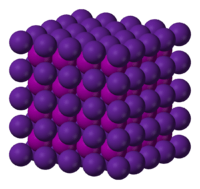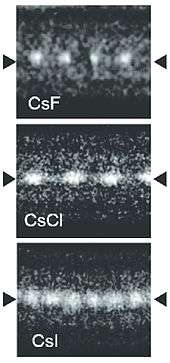Caesium iodide
 | |
| Names | |
|---|---|
| IUPAC name
Caesium iodide | |
| Other names
Cesium iodide | |
| Identifiers | |
| 7789-17-5 | |
| 3D model (Jmol) | Interactive image |
| ChemSpider | 23003 |
| ECHA InfoCard | 100.029.223 |
| EC Number | 232-145-2 |
| |
| |
| Properties | |
| CsI | |
| Molar mass | 259.81 g/mol |
| Appearance | white crystalline solid |
| Density | 4.51 g/cm3, solid |
| Melting point | 621 °C (1,150 °F; 894 K) |
| Boiling point | 1,277 °C (2,331 °F; 1,550 K) |
| 440 g/L (0 °C) | |
| Refractive index (nD) |
1.739 |
| Structure | |
| CsCl | |
| Pm3m, No. 221 | |
| a = 456.67 pm | |
| Cubic (Cs+) Cubic (I−) | |
| Hazards | |
| Flash point | Non-flammable |
| Lethal dose or concentration (LD, LC): | |
| LD50 (median dose) |
2386 mg/kg (oral, rat)[1] |
| Related compounds | |
| Other anions |
Caesium fluoride Caesium chloride Caesium bromide Caesium astatide |
| Other cations |
Lithium iodide Sodium iodide Potassium iodide Rubidium iodide Francium iodide |
| Except where otherwise noted, data are given for materials in their standard state (at 25 °C [77 °F], 100 kPa). | |
| | |
| Infobox references | |
Caesium iodide (chemical formula CsI) is the ionic compound of caesium and iodine. It is often used as the input phosphor of an x-ray image intensifier tube found in fluoroscopy equipment. Caesium iodide photocathodes are highly efficient at extreme ultraviolet wavelengths.[2]

An important application of caesium iodide crystals, which are scintillators, is electromagnetic calorimetry in experimental particle physics. Pure CsI is a fast and dense scintillating material with relatively high light yield. It shows two main emission components: one in the near ultraviolet region at the wavelength of 310 nm and one at 460 nm. The drawbacks of CsI are a high temperature gradient and a slight hygroscopicity.
Caesium iodide is used as a beamsplitter in Fourier transform infrared (FTIR) spectrometers. It has a wider transmission range than the more common potassium bromide beamsplitters, extending its working range into the far infrared. However, optical-quality CsI crystals are very soft and a hard to cleave or polish. They should also be coated (typically with germanium) and stored in a desiccator, to minimize interaction with atmospheric water vapors.[4]
Caesium iodide atomic chains can be grown inside double-wall carbon nanotubes. Accurate measurements reveal that in such chains I atoms appear brighter than Cs atoms despite having a smaller mass. This difference was explained by the charge difference between Cs atoms (positive), inner nanotube walls (negative) and I atoms (negative). As a result, Cs atoms are attracted to the walls and vibrate more strongly than I atoms, which are pushed toward the nanotube axis.[3]
References
- 1 2 Cesium iodide. U.S. National Library of Medicine
- ↑ Kowalski, M. P.; Fritz, G. G.; Cruddace, R. G.; Unzicker, A. E.; Swanson, N. (1986). "Quantum efficiency of cesium iodide photocathodes at soft x-ray and extreme ultraviolet wavelengths". Applied Optics. 25 (14): 2440. doi:10.1364/AO.25.002440. PMID 18231513.
- 1 2 Senga, Ryosuke; Komsa, Hannu-Pekka; Liu, Zheng; Hirose-Takai, Kaori; Krasheninnikov, Arkady V.; Suenaga, Kazu (2014). "Atomic structure and dynamic behaviour of truly one-dimensional ionic chains inside carbon nanotubes". Nature Materials. 13 (11): 1050. doi:10.1038/nmat4069. PMID 25218060.
- ↑ Sun, Da-Wen (2009). Infrared Spectroscopy for Food Quality Analysis and Control. Academic Press. pp. 158–. ISBN 978-0-08-092087-0.